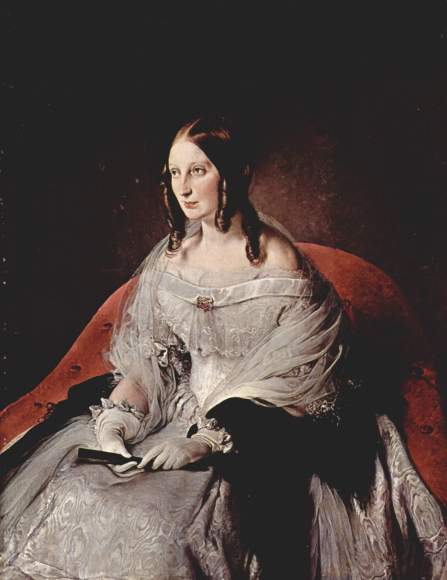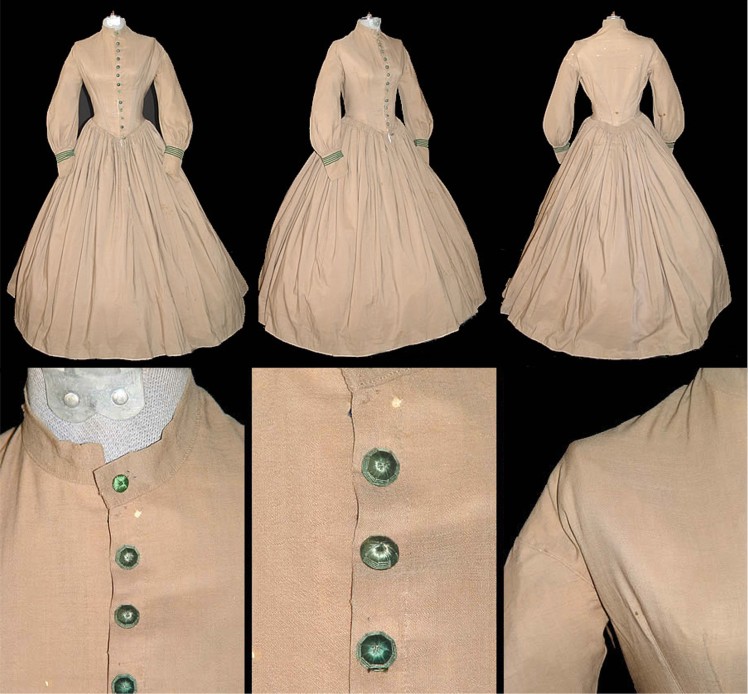
She was the daughter of a schoolteacher, he worked as an assistant in a tax commissionership.
Meet Fanny Katharina Friederike, my great-grandmother’s great-grandmother. She was born in 1827 to a schoolteacher and his wife and is therefore likely to have been a middle-class woman. She grew up, married at the age of 25 and later still lived in Hessia, Germany, to an age of 50 when she died of pneumonia. Fanny had at least 7 children of whom one, Phillipina, died few months after she was born. Fanny also was three years her husband Hugo’s senior and he remarried after her death – being just 47, he wed a woman called Christina who bore him another child and outlived him after he died in a hospital in 1896.
I have been fascinated with Fanny’s picture since I first laid eyes on it. Ever since, I’ve wondered whether it is a photograph or drawing, because I’m only in possession of a digital copy of her picture in a genealogical table. According to my own idea of 19th century photography, I would assume it’s rather a drawing, but I can’t be sure before I have a look at the original page of the table. And even then I might be wrong.
But, however, having collected some information on Fanny’s circumstances in life, I had a closer look at her picture and tried to make a few revelations on who she really was.

Firstly, her hair: it tells us a lot about the time the picture possibly dates. The hair is parted twice in the middle, arranged in two ‘Spaniel’ curls framing her face and gathered in a braided bun on top of the back of her head.

The Princess di Sant Antimo by Francesco Hayez, source: wikipedia.org
A portrait of the Princess di Sant Antimo by Francesco Hayez, dating back to 1840-44 shows the lady with curls and a bun just like Fanny’s, only the ‘Spaniels’ are longer and there are at least three of them. In the 1840s, Fanny was just in her teens, and the picture shows her in her mid-20s to early 30s, at least so I guess. Considering her position as the daugther of a schoolteacher and later the wife of a middle-class assistant in a tax commissionership in a rather small, almost rural town, she might very well have lagged behind time when it came to fashion.

Emilie Feustell by Christian Tunica, source: wikipedia.org
Annette von Droste-Hülshoff by Johann Joseph Sprick, source: wikipedia.org
Charlotte Bronson at the age of 18, source: retronaut.com
The double-parting of hair was fashionable in the ‘Biedermeier’-period (1814-1848), as it can be seen in this portrait of Emilie Feustell by Christian Tunica and the one of Annette von Droste-Hülshoff by Johann Joseph Sprick (1838), and would have been outdated as well when Fanny’s picture was taken/painted. But this photo from 1850 (then, Fanny was 23) shows a double parting like Fanny’s again – so my ancestor wasn’t that unfashionable after all. The different elements blend together quite well into a classic hairstyle – decent, but not exactly plain.

Bottom: Golden ‘poissardes’ in a rather simple style, source: bijoux.gazette-art.com
Now, onto her earrings, which are, to say the truth, scarcely visible. Still, I did a little research on the Biedermeier era and learned that people saved money (due to the Napoleonic Wars ending in 1815) and reduced their jewellery to obligatory earrings which were a must. I hit upon a special sort of earrings which were fashionable from 1789 to about 1830: they were called ‘poissardes’, ‘fishwives’, because they were a rather big kind of creoles with an extra S-shaped part to relieve the strain, but light and therefore cheap. People of course had to economize, and although Fanny was just an infant when poissardes were ‘á la mode’, I believe that she is wearing this kind of jewellery. If it’s indeed a painting, the artist might have reduced them to a plain circle, or they actually were that simple. She could have inherited them from their mother (born in 1804) or one of her grandmothers (born in 1770 and 1775). And maybe I was just overresearching and these earrings are simply a lovely little gift from her husband.


Late 1850s gown with 1840s sleeves and bodice, source: sensibility.com
In Hushed Tones by Goupil Jules Adolphe, source: costumeantique.de
When it comes to clothes, there is hardly a collar to work with. But it reminds rather of 1850s/1860s high-necked everyday-dresses, as shown in this photograph from the 1850s (the text next to this one said the lady was keeping the old-fashioned sleeves and short-waisted bodice of the 1840s, although the width of the skirt is typically late 1850s) and in this painting by Goupil Jules Adolphe from 1865 (then, Fanny was 38, only just within our timeframe).

I’ve also found the perfect Fanny-dress (ok, it’s small and most certainly belonged to a younger girl but however), since the colour, material and style seem to fit her position quite well. It’s possibly from the 1850s and therefore even hits our time frame.
So, after a good deal of research and an even greater deal of speculation, I assume Fanny, who was 20 when the famous novel was published, didn’t look unlike the numerous versions of lovely governess Jane Eyre – a plain, but somehow fascinating woman.
Well done. Enjoyed this post very much.
LikeLike
Thank you kindly. I’m fond of genealogy (your blog is a true treasure!) and have especially been tracing the line of my maternal great-grandmother’s family back to the late 17th/early 18th century. And I’ll certainly share more of my findings.
LikeLike
what an interesting piece!
LikeLike
Thank you again, I’ll soon be writing about Fanny’s husband Hugo as well. There’s always something to dig up.
LikeLike
well said and well done…unfortunately we (me included) tend so much these days to skim over things!
LikeLike
True indeed. And I think their lives were so hard that they deserve to be remembered.
LikeLike
yes, and this is very inspiring!
LikeLike
Dear Anna, Just loved your article about Fanny and Hugo. Maybe I should share some more of my discoveries! Look forward to following your blog and thank you for finding mine!
Barbara in Australia
LikeLike
Thank you so much, what a delight to hear that. I intend to write especially about Hugo as well. And it’s a pleasure to read your posts!
LikeLike